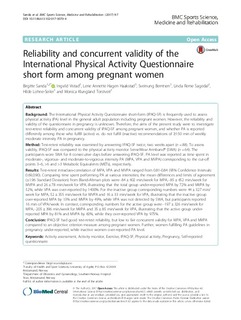Reliability and concurrent validity of the International Physical Activity Questionnaire short form among pregnant women
Sanda, Birgitte; Vistad, Ingvild; Haakstad, Lene Annette Hagen; Berntsen, Sveinung; Sagedal, Linda Reme; Lohne-Seiler, Hilde; Torstveit, Monica Klungland
Journal article, Peer reviewed
Published version
Permanent lenke
http://hdl.handle.net/11250/2496972Utgivelsesdato
2017Metadata
Vis full innførselSamlinger
Originalversjon
BMC sports science, medicine and rehabilitation. 2017, 9:7 1-10. 10.1186/s13102-017-0070-4Sammendrag
Background: The International Physical Activity Questionnaire short-form (IPAQ-SF) is frequently used to assess physical activity (PA) level in the general adult population including pregnant women. However, the reliability and validity of the questionnaire in pregnancy is unknown. Therefore, the aims of the present study were to investigate test-retest reliability and concurrent validity of IPAQ-SF among pregnant women, and whether PA is reported differently among those who fulfill (active) vs. do not fulfill (inactive) recommendations of ≥150 min of weekly moderate intensity PA in pregnancy. Method: Test-retest reliability was examined by answering IPAQ-SF twice, two weeks apart (n = 88). To assess validity, IPAQ-SF was compared to the physical activity monitor SenseWear Armband® (SWA) (n = 64). The participants wore SWA for 8 consecutive days before answering IPAQ-SF. PA level was reported as time spent in moderate-, vigorous- and moderate-to-vigorous intensity PA (MPA, VPA and MVPA) corresponding to the cut-off points 3–6, >6 and >3 Metabolic Equivalents (METs), respectively. Results: Test-retest intraclass-correlation of MPA, VPA and MVPA ranged from 0.81-0.84 (95% Confidence Intervals: 0.69,0.90). Comparing time spent performing PA at various intensities; the mean differences and limits of agreement (±1.96 Standard Deviation) from Bland-Altman plots were−84 ± 402 min/week for MPA,−85 ± 452 min/week for MVPA and 26 ± 78 min/week for VPA, illustrating that the total group under-reported MPA by 72% and MVPA by 52%, while VPA was over-reported by 1400%. For the inactive group corresponding numbers were 44 ± 327 min/week for MPA, 52 ± 355 min/week for MVPA and 16 ± 33 min/week for VPA, illustrating that the inactive group over-reported MPA by 13% and MVPA by 49%, while VPA was not detected by SWA, but participants reported 16 min of VPA/week. In contrast, corresponding numbers for the active group were−197 ± 326 min/week for MPA,−205 ± 396 min/week for MVPA and 35 ± 85 min/week for VPA, illustrating that the active group under-reported MPA by 81% and MVPA by 60%, while they over-reported VPA by 975%. Conclusion: IPAQ-SF had good test-retest reliability, but low to fair concurrent validity for MPA, VPA and MVPA compared to an objective criterion measure among pregnant women. Further, women fulfilling PA guidelines in pregnancy under-reported, while inactive women over-reported PA level.

